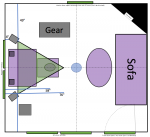I'm really sorry guys, but I see so many people chasing their tales, especially using ease in venues. They wander around waving their mics, making odd noises and producing wonderful graphs, waterfall plots and determine that this wrong, that is wrong and to cure it we need to do this, and that, and usually spend money. Many are very old listed buildings and then the people come in, and the acoustics change and suddenly get hugely better. The Victorian architects didn't have prediction and measurement software, just ears and experience.
What I meant with my glib comment about what does it sound like is that what it sounds like often argues with what it looks like!
Does the room sound dull or bright, obviously heavy at the bottom or missing the bottom totally - does it sound just dull, or have peculiar nodes where the sound changes with just a bit of ear movement. I always listen to every space I work in, and my ears tell me what it's likely to need to tame it. If you see a small room with parallel walls and surfaces that are hard you know it's going to sound boxy - I looked at all those wonderful plots and just thought that I had no idea what it sounds like. I cannot (what is the audio version of visualise?) imagine what it sounds from those. Confused? Yep, unbalanced, unfocussed, weird stereo image as the response clearly changes with frequency - but I have no idea if I could live with it.
Uhm...yeah. Here is where your comment has merit. Having good ears and instincts (which really are insights gained over time) is very important. Most importantly, what you hear over and over is that reference monitoring is the best tool, especially if there are some songs you know really, really well.
Relative to your comments about measurements and treatment, ah physics is physics even if you don't understand it. There are before and after examples all over the internet that show how a space was improved and almost any professional will say you need to work in as accurate a room as possible.

 ...yeah, OK.
...yeah, OK.







